Prof Eva-Maria Thüne: Using language portrait silhouettes to explore and validate linguistic repertoires - On campus workshop, 6th May 2022

In this lively workshop, language teachers and students explored the use of language portraits, starting from their own plurilingual experiences. Prof Eva-Maria Thüne, University of Bologna [https://www.unibo.it/sitoweb/evamaria.thune/en] demonstrated how language portrait silhouettes have been widely used since the 1990s. They can give a holistic representation of what languages mean to multilingual speakers and how they can represent not only their competences and knowledge, but their “being in the language” (“In-der-Sprache-Sein”, Heidegger). Language portrait silhouettes are at the interface between biography and discourse. They give insight into how speakers represent themselves in ‘images’, but the portraits are often connected with their narrations about language acquisition and use. In producing these narratives students can unfold their language repertoire in which dominant and dormant languages can find their place. Language portraits can therefore make an important contribution to the interactional process in the language class.
Participants completed and reflected on their own language portraits. Based on their first-hand experiences, they explored the possibilities of using linguistic repertoires in the language classroom.
Please find the slides to the workshop here.
The event is part of the CTELL events series 'Variation and Change in Language Learning and Literacy Development'.
Bibliography:
Busch, B. (2017) ‘Expanding the Notion of the Linguistic Repertoire: On the Concept of Spracherleben – The Lived Experience of Language’ Applied Linguistics 38/3: 340-358.
Busch, B. (2021) ‘The body image: taking an evaluative stance towards semiotic resources’. International Journal of Multilingualism https://doi.org/10.1080/14790718.2021.1898618

.png)